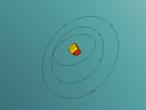Sulfur atom by Grace Dowdle
In this blog post, I will be informing readers about the composition, structure and characteristics of a chosen atom, sulfur, and I will display the 3D model that myself and my partner created.
Did you know that Io, Jupiter's fourth-largest moon, has a yellow hue because of sulfur deposits? Sulfur is the 16th element on the Periodic Table of Elements, discovered by Antoine-Laurent de Lavoisier who is regarded as the Father of Modern Chemistry. This element is an essential component of all living cells and is the third most abundant element in the human body (by weight). It is concentrated in the muscles, skin and bones, and makes up vital amino acids used to create protein for cells and tissues. Additionally, sulfur is found naturally in areas around hot springs, volcanic regions, iron pyrites, galena and various other minerals. Furthermore, elemental sulfur is used in black gunpowder, matches, fireworks, in the hardening of rubber, as an insecticide, and in the treatment of certain skin diseases.
Sulfur is a pale, yellow, odourless, brittle solid that is non-metallic and is represented by the symbol S in the Periodic Table. It has the atomic number of 16, an atomic mass of 32.066 amu, and has many isotopes (variants of a particular element due to different neutron numbers), four of which are stable. This atom is composed of 16 protons, 16 neutrons and 16 electrons. It is solid at 20˚C and is classified as a non-metal and is also non-radioactive. The element is part of group 16 and belongs to the oxygen family since both their outer shells contain six electrons.
A sulfur atom has three shells with two electrons being held in the first, eight electrons in the next, and six in the final. The element also has 25 known isotopes with sulfur-32, 33, 34 and 36 being stable, though sulfur-35 is radioactive, and has a half-life of 87.5 days. These variances in mass number are due to different amounts of neutrons in the nucleus. In the solid form, elemental sulfur links to form kinked octagonal rings, held together by weak residual forces, which alternate in staggered rows. In addition, there are over 30 allotropes (the property of a chemical element to exist in two or more forms) of sulfur, with the most common being octasulfur. Octasulfur crystallises in three polymorphs: rhombic, monoclinic and plastic. While the rhombic and monoclinic structures are stable, the plastic structure is unstable and can immediately change into rhombic upon heating.
Sulfur is a poor conductor of electricity and is insoluble in water, but is soluble in carbon disulfide. Due to lots of interatomic space, the atom is less dense with a density of 2.07g per cubic centimetre. It has a melting point of 112.8˚C, and a boiling point of 444.6˚C. Upon melting, sulfur is converted into a yellow flowing liquid, that turns brown and eventually dark brown as it becomes more viscous at 190˚C. However once it reaches 300˚C, it becomes a flowing liquid again. Sulfur burns with a blue flame and oxidises to sulfur dioxide, a poisonous gas. However, pure sulfur is considered to be of low toxicity. Sulfur is chemically reactive, especially after heating, and combines with almost all other elements. The most well known sulfur compound is hydrogen sulfide, a pungent and toxic gas that is used in stink bombs.
For further information about sulfur, feel free to visit these links:
https://www.hobart.k12.in.us/ksms/PeriodicTable/sulfur.htm and http://www.lookchem.com/Periodic-Table/Sulfur/
http://www.elementalmatter.info/sulfur-properties.htm
http://www.chemicalelements.com/elements/s.html
https://www.uwgb.edu/dutchs/Petrology/SulfurStructure.HTM
http://www.business-science-articles.com/matric/chem/355-allotropes-of-sulphur-rhombic-sulphur-monoclinic-sulphur-plastic-sulphur
http://www.ducksters.com/science/chemistry/sulfur.php
Something I would like to further investigate is sulfur compounds such as hydrogen sulfur, sulfur dioxide and carbon disulfide. Since this assessment task was focussed on the composition, structure, and composition of an atom (sulfur), a question I have is, how is sulfur used to treat skin diseases?
Initially, a difficulty I had in this workshop was the actual programming. Since I had never programmed anything before, I found it difficult to understand the concepts, especially how to create a code. Thus, I had to do everything manually, through trial and error, which was extremely time consuming. In addition I had difficulty making the nucleus of sulfur a spherical shape which resulted in it looking slightly deformed. Another difficulty I encountered was the direction of the turtle and at times, I could not figure out which direction to move, rotate, roll or tilt it.
Site used for programming:
https://vrmath2.net/VRM2/
By Grace Dowdle (ASC091D)
Groups:























